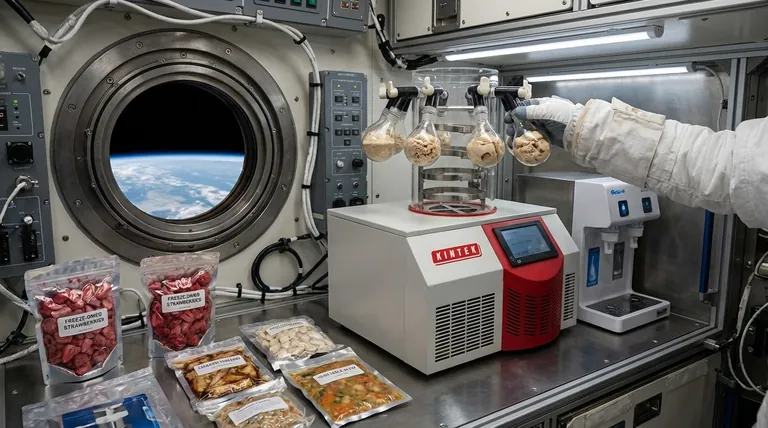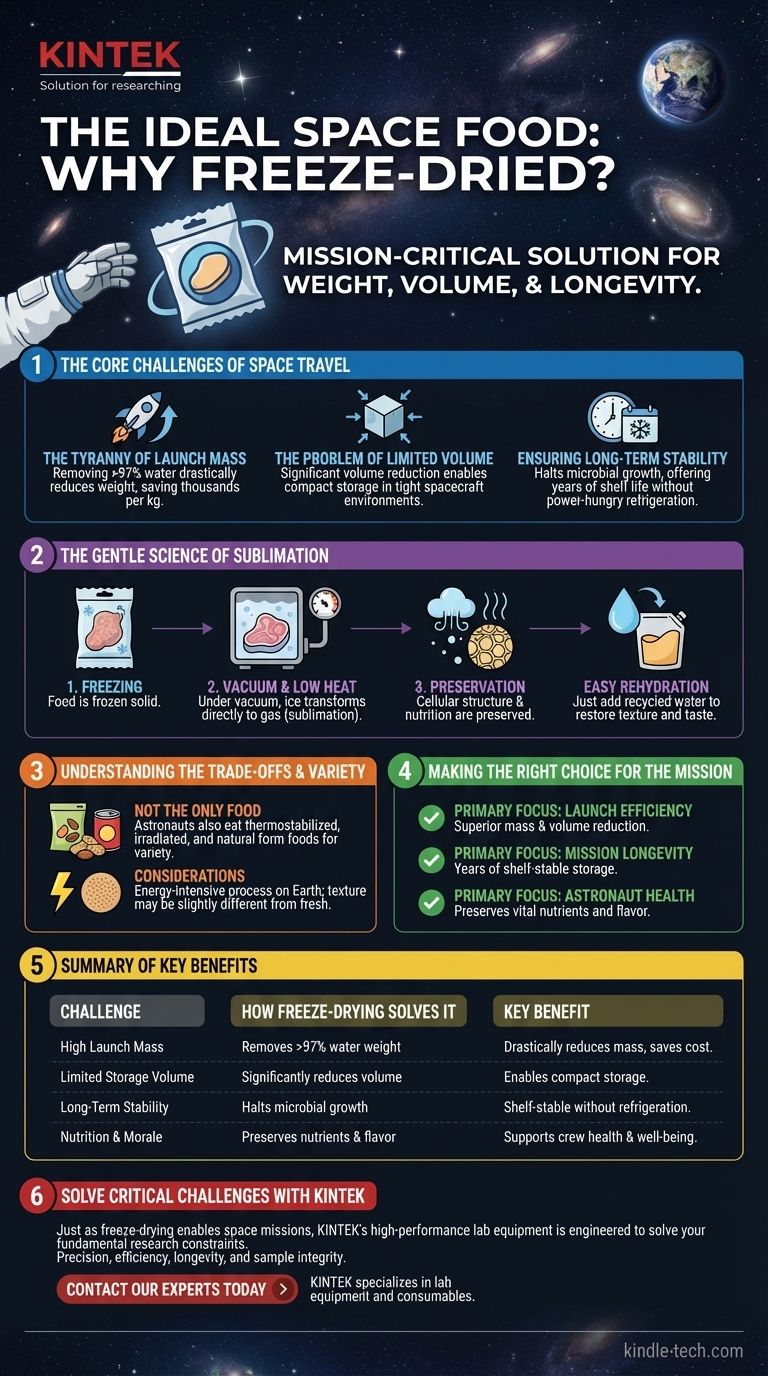For missions where every gram is counted and resupply is impossible, freeze-dried foods are the optimal solution. They solve the immense logistical challenges of space travel by being exceptionally lightweight, compact, and shelf-stable for years without refrigeration, while still retaining vital nutrients and a high degree of their original flavor.
The use of freeze-dried food in space is not a matter of culinary preference; it is a direct and elegant engineering solution to the fundamental constraints of launch mass, storage volume, and long-term preservation that define human spaceflight.

The Core Challenges of Feeding Astronauts
To understand why freeze-drying is so dominant, you must first appreciate the severe limitations of operating in space. Every system, including food, is designed around solving these core problems.
The Tyranny of Launch Mass
Sending anything into orbit is extraordinarily expensive. The cost is measured in thousands of dollars per kilogram.
Water is heavy. By removing nearly all of it—often over 97%—the freeze-drying process drastically reduces the weight of the food. This makes it the most mass-efficient preservation method available.
The Problem of Limited Volume
A spacecraft is a tightly confined environment where every cubic centimeter is valuable. There is no room for bulky packaging or the large volume of fresh foods.
Freeze-drying not only removes water weight but also significantly reduces the food's volume. The resulting product is dense and compact, allowing for a large supply of meals to be stored in a minimal amount of space.
Ensuring Long-Term Stability
Space missions can last for months or even years. Without refrigeration, which consumes power and generates heat, conventional food would spoil in days.
The removal of water halts the growth of bacteria and other microorganisms, the primary causes of spoilage. This gives freeze-dried food a shelf life of several years at room temperature, ensuring a safe and reliable food source for the entire mission duration.
How Freeze-Drying Preserves Food and Nutrition
Freeze-drying is a sophisticated process, technically known as lyophilization, that is far gentler than simple dehydration. It uniquely preserves the food's structure and nutritional integrity.
The Science of Sublimation
The food is first frozen solid. It is then placed in a strong vacuum chamber.
Under this low pressure, the temperature is slightly raised. This causes the frozen water crystals to transform directly from a solid (ice) into a gas (water vapor), a process called sublimation.
Because the water is never in a liquid state, it doesn't damage the food's cellular structure. This is why freeze-dried foods rehydrate so well and retain their original shape, texture, and taste far better than foods that are simply dried with heat.
The Importance of Rehydration
On a spacecraft, water is a recycled and readily available resource, often produced as a byproduct of the onboard fuel cells.
Astronauts simply inject a precise amount of hot or cold water into the food package. Within minutes, the food is rehydrated and ready to eat, restoring much of its original quality.
Understanding the Trade-offs
While ideal for space, freeze-drying is not a perfect or universal solution. Objectivity requires acknowledging its limitations.
Not the Only Food in Space
Astronauts eat a varied diet. In addition to freeze-dried meals, they consume thermostabilized (canned or pouched) foods, irradiated meats to prevent spoilage, and natural form items like nuts, granola bars, and tortillas. This variety is critical for morale.
Texture and Flavor Changes
Although freeze-drying is the best preservation method for texture, it isn't flawless. Some foods, particularly complex dishes, may not rehydrate perfectly and can have a slightly spongy or dry texture compared to their fresh counterparts.
Energy-Intensive Process
On Earth, freeze-drying is an expensive and energy-intensive process compared to other preservation methods. However, this high upfront cost is easily justified by the immense savings in launch mass.
Making the Right Choice for the Mission
The decision to rely heavily on freeze-dried food is a clear-cut choice driven by the non-negotiable physics and economics of space travel.
- If your primary focus is launch efficiency: Freeze-drying is the superior choice because removing over 97% of water's mass and volume directly reduces the two most expensive factors in space logistics.
- If your primary focus is mission longevity: The process creates a product that is shelf-stable for years without refrigeration, eliminating food spoilage as a critical mission risk.
- If your primary focus is astronaut health: Freeze-drying preserves nutritional value and flavor far better than simple heat dehydration, supporting the physical and psychological well-being of the crew.
Ultimately, freeze-drying is not just a food preparation technique; it is a critical enabling technology for long-duration human spaceflight.
Summary Table:
| Challenge | How Freeze-Drying Solves It | Key Benefit |
|---|---|---|
| High Launch Mass | Removes over 97% of water weight | Drastically reduces mass, saving thousands per kilogram |
| Limited Storage Volume | Significantly reduces food volume | Enables compact storage of a large food supply |
| Long-Term Stability | Halts microbial growth by removing water | Shelf-stable for years without power-hungry refrigeration |
| Nutrition & Morale | Preserves nutrients and flavor via gentle sublimation | Supports astronaut health and well-being on long missions |
Ready to solve your critical laboratory challenges with precision equipment?
Just as freeze-drying is a critical enabling technology for space missions, KINTEK's high-performance lab equipment is engineered to solve the fundamental constraints of your research and development. Whether your focus is on precision, efficiency, longevity, or sample integrity, we provide the reliable tools you need to succeed.
KINTEK specializes in lab equipment and consumables, serving diverse laboratory needs. Let us help you achieve your mission's goals. Contact our experts today to discuss how our solutions can bring efficiency and reliability to your work!
Visual Guide

Related Products
- Benchtop Laboratory Freeze Dryer for Lab Use
- Benchtop Laboratory Vacuum Freeze Dryer
- Laboratory Sterilizer Lab Autoclave Pulse Vacuum Lifting Sterilizer
- Laboratory Sterilizer Lab Autoclave Vertical Pressure Steam Sterilizer for Liquid Crystal Display Automatic Type
- Laboratory Test Sieves and Sieving Machines
People Also Ask
- What are some common uses of freeze drying? Preserve Delicate Materials with Precision
- What types of liquid samples can be processed using a laboratory freeze dryer? Preserve Your Sensitive Materials
- What is the freeze drying or lyophilisation process? A Guide to Gentle, High-Quality Dehydration
- Why is freeze drying considered more effective than ordinary drying? Preserve Structure, Nutrients & Flavor
- What is the primary function of a freeze dryer in a laboratory setting? Preserve Delicate Materials with Sublimation



















